Stroll with Me through the Rice University Campus
Dennis Carnes | January 27, 2020
Photos by Gretchen Kuhn
I’m a Trillinite. Not a trillionaire, a Trillinite. Calvin Trillin knows how to travel well. He doesn’t waste time bagging monuments. Big Ben, the Houses of Parliament, and the Eiffel Tower look just like the dozens of pictures you have seen of them. Don’t even think about trying to see the Mona Lisa in the Louvre, unless you play center for an NBA team and soar above the heads and upheld cameras of your fellow tourists. You probably won’t be able to get into the room where she presides because there are so many people crushing, pushing, and shoving, to see her, or more likely, to snap a photo to impress those back home.
No, that’s not for Calvin Trillin. When he travels, Trillin looks for the simple and profound. He loves village food markets. He delights in a well-formed cucumber, a golden lemon, and food he’s never encountered. He spent weeks playing foosball with his two young daughters in a bar in a small Italian village.
So, when out-of-town guests arrive, don’t just whisk them off to Houston’s fabulous museums, our world class symphony orchestra, our fountains, or our parks. Take them “inside the hedges” to the oasis in the city, the Rice University campus. Join me in a stroll through this jewel.
Before we strike out, let’s review some facts about Rice. Rice sits on a roughly pentagonal-shaped campus. Its 300 tree-lined acres earned a designated arboretum status. Between Gates 1 and 2 is the eighteen-inch tall Moon Tree. One of our astronauts carried the seeds for the tree to the moon on Apollo 14.
The student body consists of 4,000 undergraduate and 3,000 graduate students. The student-to-teacher ratio is 6:1. The median class size is 14. Rice is a selective university that accepts only 16% of applicants. Ninety-two percent of Rice students graduate. Ninety-seven percent of Rice women athletes graduate, the highest percentage in the country. People who rate colleges and universities usually include Rice among the top 100 universities in the world. The Princeton Review ranked Rice students the happiest in the nation.
Businessman William Marsh Rice chartered the university in 1891 as a gift to Houston. The story goes that in 1900 Rice’s valet Charles Jones found Rice dead in his bed, presumably having died in his sleep. Rice’s attorney, Captain James A. Baker, found evidence of poisoning. The District Attorney charged unscrupulous lawyer Albert Patrick with poisoning Rice. Valet Jones agreed to testify. Patrick was convicted and sent to Sing Sing. He was pardoned in 1912, the same year Rice University began classes.
Experienced travelers know that the approach to a site is everything. Often that means approaching a city from the sea, as the ancient ones did. We can’t approach Rice from the sea, so let’s begin our day by driving through Gate 1, at South Main and Sunset streets. Let’s park on the tree-lined street that terminates at the east entrance to Lovett Hall, now the home of the administrative offices. Let’s take a moment to look at Lovett Hall. As with most Rice buildings, it is in a Mediterranean Revival style. We’ll walk through the Sallyport, the archway leading into the academic quad, making sure to look up at the archway and discover its delights.
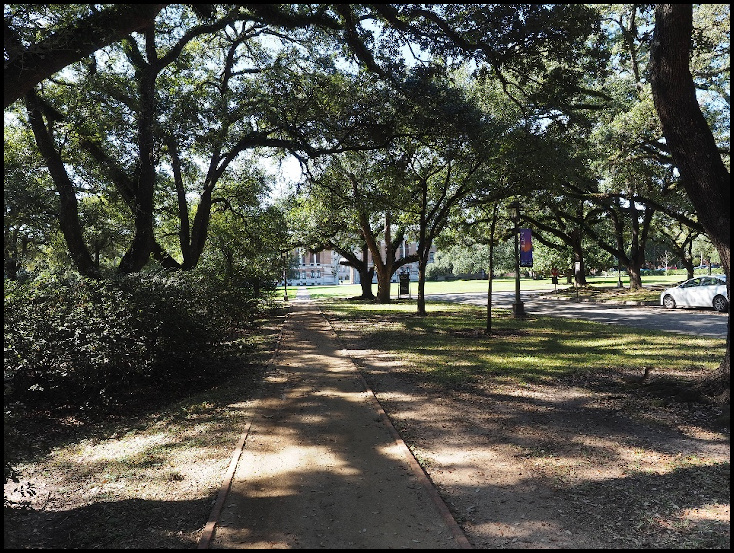
After entering freshman move into their residential colleges (more about the residential college system later), they gather in Tudor Fieldhouse. Rice President David Leebron addresses them, ending with “Don’t do something stupid.” This, after administrators have politely told the students’ parents to go home.
After the speech, the students walk from Tudor Fieldhouse to Lovett Hall and through the Sallyport. They are dazzled by a magnificent fireworks display. Upperclassmen from their colleges cheer them on. The legend is that if a student walks through the Sallyport again before graduating, he will not graduate.
We are now standing in the academic quad. Let’s savor the 360-degree view of the original classroom buildings, still in use. Now we will look west. The academic quad is anchored by a statue of William Marsh Rice, the “Willy statue.” Beyond that is Fondren Library. Why was the library built in a Stalinist style? It incongruously juts out of the far west end of the academic quad.
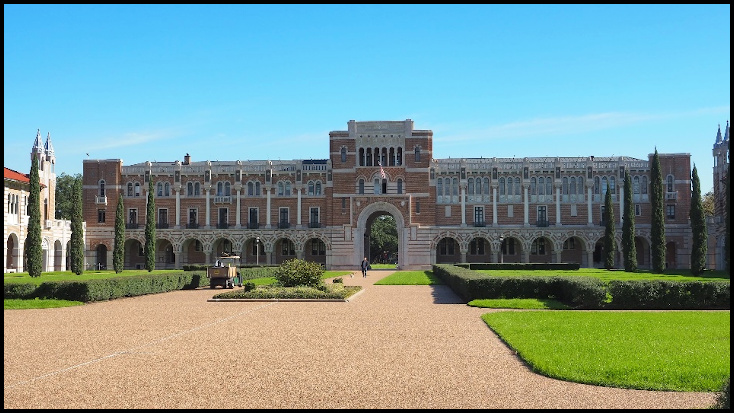
In 1988 ten students and one alum turned the 2,000-pound Willy statue 180-degrees so that it faced Fondren Library. They did it without using a crane. A Rice security guard came by and asked them what they were doing. They told him it was class project, so he walked away. Only one student was caught.
We walk toward Fondren Library (the students call it “Club Fondy” because they spend so much time there during finals). Let’s sit on the benches outside Fondren. Remember, we are Trillinites. We take a few minutes and look at the academic quad again. Really look. Look at the grass, the flowers, the buildings. We listen. What do we hear? Nothing. Absolutely nothing. Isn’t it astonishing that we are engulfed by six million people, driving their cars and trucks, mowing their lawns, blowing leaves around, and repairing streets, yet we hear nothing?
We walk around to the front of Fondren. When we arrive at the north side, we see why the Rice campus is an arboretum. Look at all the trees that border the street!
We continue to walk around Fondren until we reach the back entrance of the Raymond and Susan Brochstein Pavilion. Let’s go inside and have a coffee and maybe a snack. The pavilion was built in 2009 as a place for students, professors, and campus visitors to meet. Most of the students will be hunched over their computers, textbooks open. Others will be chatting with their professors. On Saturday, Rice President Leebron and his wife, Y. Ping Sun, might walk by with their dog and visit with a student or two.
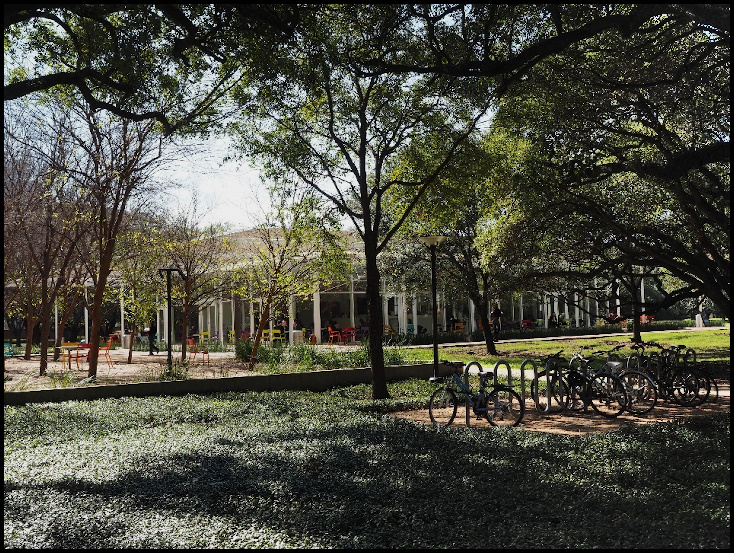
We then walk west through the Brochstein Pavilion and outside onto the terrace. We take a moment to absorb the green lawn, trees, public sculptures, and café tables under the trees.
By now you might be wondering where the students are. Again, it’s quiet. The students are in class, in labs, or in their colleges. No one is playing frisbee on this lawn. No one is lolling about.
We turn left and walk south toward the residential colleges. Let’s stop in front of Baker College, the oldest of the eleven colleges. The colleges are central to the lives of the students. They were inspired by the systems at Oxford and Cambridge. The colleges establish their own governments, put on their own plays, relax during their own social events, and field their own athletic teams. Students are assigned randomly to their colleges without regard to their fields of study. Rice has no athletic dorms. Your suite mates might be an athlete, a student from Hong Kong, an accomplished pianist from Peru, or a student from the smallest Texas hamlet. When Rice alumni meet, their first question is, “What was your college?”
When asked about their years at Rice, alumni nearly always say, “I met and became friends with amazing people.” Many of them are lifelong friends. A couple of years ago, the President of the Alumni Association, during her address to the matriculating freshmen, described her experience in her residential college this way: “Little did I know that my (residential) college friends included a future astronaut, a Congressman, and the doctor who helped deliver my children during my difficult pregnancy.”
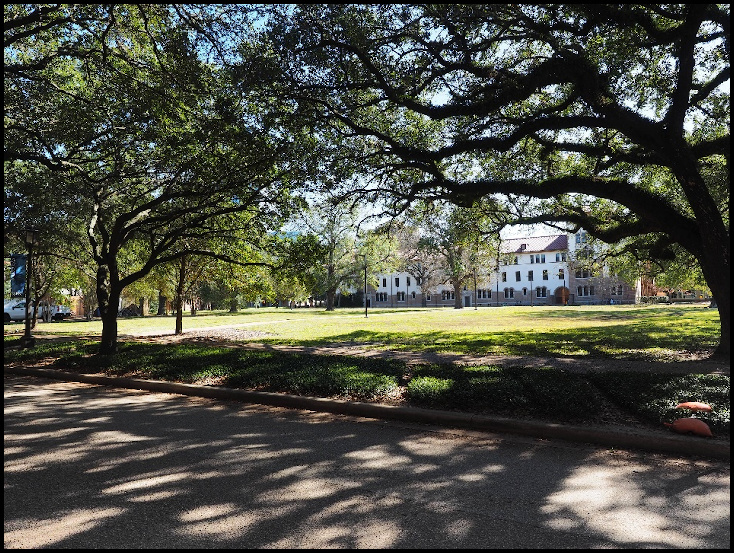
We’ll continue to walk west under the canopy of another tree-lined street. We’ll turn right, north, on the next street. Let’s take a moment to look at the fragment of the Berlin Wall. Reaching the fragment tells us we have reached the Baker Institute for Public Policy. Founded by James A. Baker, III, it draws secretaries of state, foreign ministers, and even presidents who address the Institute’s members. U.S. Secretary of State Pompeo spoke, as did President Obama.
We continue to head north. Let’s walk through the student union, which is named the Rice Memorial Center and usually called the RMC. We stop at the student-run coffee shop and glance at the students who are studying. Across from the south entrance of the RMC we visit the Rice Chapel, a popular choice for couples to celebrate their marriage.
We turn around and walk west again. As we cross the street in front of the RMC, we see the Barbara and David Gibbs Recreation Center. Barbara and David both graduated from Rice. When you ask Dr. Gibbs why she and David funded the building, she will tell you that David, who plays basketball every day at Rice, asked, “What do I have to do to get a parking place?” An administrator told him, “Build a building.” It’s not a true story but a fun one. We can visit the recreation center by telling the person at the front desk that we would just like to look around. It is a complete facility, including weights, aerobic equipment, and basketball and other courts.

Notice the bear and bull statues flanking the entrance.
We leave and walk by the outdoor swimming pool, where the Rice swimming team practices and competes. We retrace our steps and enter the grassy area north of the Baker Institute. The business school is on our right, its entrance flanked by statues of a bull and a bear. We again cross an open lawn until we approach the James Turrell Epiphany Skyspace. The ground rises to resemble what? An ancient Native American tomb? We enter the skyspace and look up. The best times to visit the skyspace are at sunrise and sunset, when the ceiling changes colors.
The skyspace prepares us for the Shephard School of Music just beyond. The Shepherd School is a world class institution that rivals the Curtis Institute and Julliard. The building contains two performance venues, the 250-seat Duncan Recital Hall and the 1,000-seat Stude Concert Hall. Student orchestra performances and instrument-specific recitals are free and open to the public. World-class chamber ensembles also perform at Stude for a modest fee. Some of the world-renowned musicians who are in Houston to perform with the Houston Symphony Orchestra conduct master classes for students. Again, these are free and open to all. (Opera star Renee Fleming taught a marvelous class to nervous and star-struck opera students.)
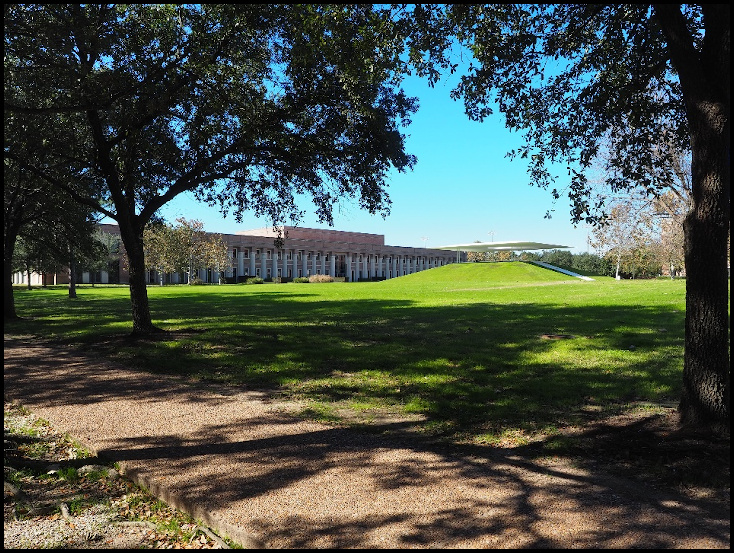
When we leave Shepherd and continue west, we’ll have to navigate around the chain-link fences that protect the construction of the new music and opera addition to Shepherd. It should be a spectacular venue, built in the Mediterranean Revival style of other Rice buildings.
We walk west on another tree-lined sidewalk. On our left is Tudor Fieldhouse, where the Rice men’s and women’s basketball teams and the volleyball team play. Rice is a Division 1 athletic university. Recently its women’s basketball, volleyball, and soccer teams have advanced to the NCAA championships. Several of Rice’s swimmers are invited to the national championships. The cross-country teams win conference championships. Some members of the track and field teams are invited to the World Championships.
One of the accomplished alumna runners is world-class half- and full-marathon runner Becky Wade. She won conference championships in several events. She has qualified for the U.S. Women’s Olympic Trials in both the half- and full- marathon. She graduated Rice with a double major, a 4.0 grade point average, and a Phi Beta Kappa distinction. Becky grew up in Dallas. Her father was Henry Wade, the Dallas District Attorney who was the defendant in the landmark U.S. Supreme Court case Roe v. Wade.
Let’s walk east again until we reach Reckling Park, the Rice baseball stadium. It opened in 2000, and its seating capacity is 7,000. Let’s pause and look at the façade. It is open and offers you a marvelous way to spend a spring evening, watching the accomplished Rice baseball team. They won the national baseball championship in 2003.
We retrace our steps, walking past Tudor Fieldhouse until we reach the Rice Moody Center for the Arts. Los Angeles architect Michael Maltzan designed the $30 million, 50,000-square-foot Center. He won the California AIA design Honor Award for designing Moody. It is an open and experimental space for the creation, teaching, and presentation of art. Inside are several quadrangles, which is an homage to the quadrangles found throughout the Rice campus. It serves as a forum for creative partnerships among not only the Houston arts community but also visiting national and international artists.
Let’s leave Moody and walk west until we reach Stockton Drive. We turn left on Stockton and stroll to the Rice Media Center on our left. International art patrons Jean and Dominique de Menil founded the Media Center in 1969. During its more than 50 years, filmmakers including Roberto Rossellini, George Lucas, Martin Scorcese, Spike Lee, Dennis Hopper, and Andy Warhol have engaged the Rice community at the Rice Media Center.
Let’s again turn around and walk north on Stockton until we reach the Glasscock School of Continuing Education. Glasscock is on our left. It is designed for working and retired adults. Experts in their fields conduct classes in foreign languages, meditation, creative writing, history, music, art, and nearly every subject its students are interested in or curious about.
Beyond Glasscock we see the football stadium. It resembles the Roman Coliseum in that thousands of fans can enter and exit in a short time. Fans don’t stand in line at the Rice football stadium. Fans, women and men, can use the ample number of bathrooms.
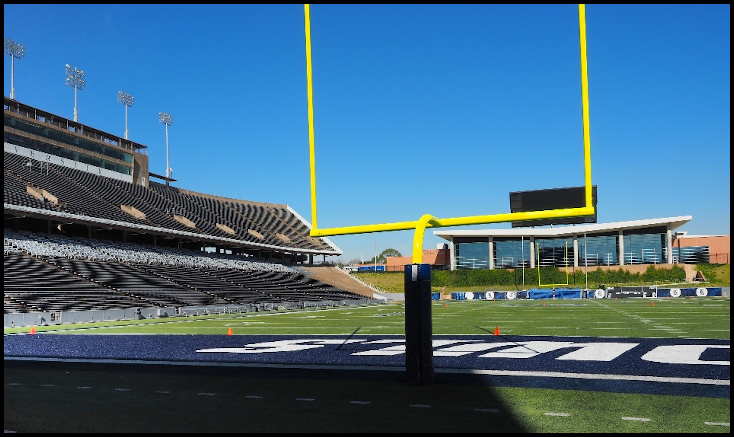
In 1962 President Kennedy spoke at the stadium and announced our goal to travel to the moon. He said, “But why, some say, the moon? Why choose this as our goal? And they may well ask why climb the highest mountain? Why, 35 years ago, fly the Atlantic? Why does Rice play Texas? We choose to go to the moon. We choose to go to the moon in this decade and do the other things, not because they are easy, but because they are hard.”
Now we must end our stroll. We didn’t walk on the outer loop, a knee-friendly running surface that circumnavigates the campus, or explore the Rice Bioscience Research Collaborative across the street from campus at University and Travis. They are something to come back to or to take your next out-of-town visitors to see.

— Email comments to Julie@bayoucitypress.com or leave public comments below.
Contact us if your comment or reply won’t post.
















Thanks so much for this beautiful, informative visit to the Rice Campus. I graduated from Rice in 1966, as did my husband, Jim Hargrove. Both our children are Rice grads also. We all have life long friends and fond memories of Rice.
Thank you, Ms. Hargrove for your lovely comment. I didn’t go to Rice but my wife did. She graduated in 1973. I love everything about Rice. Go Owls!